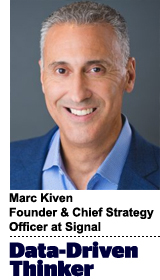 “Data-Driven Thinking” is written by members of the media community and contains fresh ideas on the digital revolution in media.
“Data-Driven Thinking” is written by members of the media community and contains fresh ideas on the digital revolution in media.
Today’s column is written by Marc Kiven, founder and chief strategy officer of Signal.
CEOs know that the most valuable customers are those they already have. Unfortunately, most marketing campaigns are still oriented toward acquiring new customers rather than nurturing existing relationships. It’s a misalignment of resources on a massive scale.
Blame this disconnect on the limited tool set constraining previous generations of marketers. Before digital and through its early years, large audiences could only be accessed through mass channels, such as TV, radio and print, with known-user marketing restricted to direct mail and telemarketing. As a result, brands, agencies and publishers created an entire culture around models that rewarded reach, volume, clicks and likes: Even if they succeeded at effective retention marketing, they didn’t get recognized for it, let alone paid for it.
Things are different now. Mass marketing and known-user marketing have converged in the addressable web. Thanks to capabilities developed within the walled gardens of Facebook and Google, known-user marketing can be done on a scale never before possible, across multiple channels. Larger swaths of TV and the open web now connect through shared common IDs, either through first-party identity assets or third-party consortiums, and brands and publishers alike have begun to combine their data, matching device IDs and hashed emails with mounting accuracy and scale.
With the tools, the expertise and the metrics needed to build loyalty and retention now widely available, marketers can focus more resources on maintaining a mutually meaningful dialogue with existing customers who are critical to the future of any business.
But even though a unified view of the consumer is possible, it won’t come to pass as long as we remain stuck in acquisition-obsessed ways of thinking. Marketing departments everywhere must reorient themselves around this new mindset.
Measure engagement, lifetime value
The buy side can lead the way by changing how it measures success. It should shift its priorities from volume and reach to KPIs that demonstrate the true depth of engagement, such as customer lifetime value.
The more you get customers to return, the greater their potential lifetime value grows. Consider that following the first purchase, customer has a 27% chance of returning to a store; the next time they visit, there is a 45% chance they’ll make a second purchase, and if they come back again, there is a 54% chance of a third transaction.
At the same time, customers who are highly engaged [PDF] with a brand are two times more open to upsell opportunities and six times more likely to try a new product or service. They are also five times more likely to only choose that brand in the future. Last, but not least, brand loyalists are four times more likely to advocate the brand to acquaintances and colleagues.
Eschew campaign-based thinking
Loyalty and retention take place on a much longer timeline than a single campaign.
Campaigns presume a finite and intermittent engagement with the consumer, but reality just doesn’t flow that way. Today’s consumer is constantly engaged with brands through digital channels, on multiple devices and at any time of the day. It’s a persistent kind of engagement that calls for a persistent approach – an always-on conversation with the always-on consumer.
Campaign-based thinking fragments that relationship into disjointed episodes. Avoid this mentality by understanding that even if campaigns are executed by a separate agency or new technology, it’s ultimately just another chapter in an ongoing conversation.
Own the relationship and the data that makes it possible
It becomes difficult to maintain a unified view of the consumer when marketing stacks are fragmented into a tangle of vendors and point solutions. Marketers need to ensure that their technology stack supports them in fostering retention and loyalty – and that means consolidating customer-level data into a centralized location that doesn’t disappear with any one vendor or component of the stack. Ownership of the customer data belongs with the brand, not with its agency or technology partners.
Ignore retention at your peril
Reorganizing our outlook and rethinking our approach as marketers is an admittedly difficult challenge, but with large platforms threatening to intermediate the relationship with consumers, an effective loyalty strategy is an imperative for every brand.
Marketers that remain focused on acquisition alone will lose out quickly in this environment. They say that 80% of a brand’s profits come from 20% of its existing customers. Marketers who fail to retain their best customers will inevitably fail to retain their jobs, too.
Follow Signal (@Signal) and AdExchanger (@adexchanger) on Twitter.
This post was syndicated from Ad Exchanger.

More Stories
Taste paradise with Whittaker’s new Mango & Coconut block
Temu’s Advertising Avalanche Is Impossible to Ignore
Publicis Media Exchange ANZ appoints Anthony Ellis as CEO